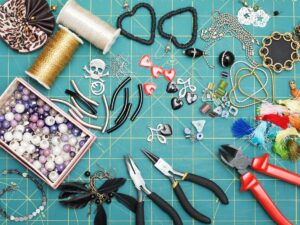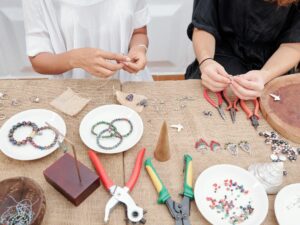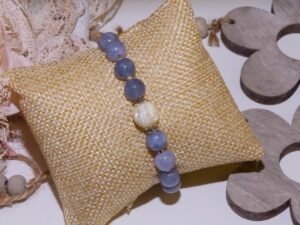This comprehensive article will unveil a seamless bangles making process to kick-start a golden journey in the jewelry business.
With our years of experience and meticulous research, this piece was crafted.
Explore further to witness the fusion of tradition and modernity mirrored in the meticulous craftsmanship detailed throughout this bangles making process guide.
Get ready to wander the golden path of jewelry entrepreneurship. Read on!
Step#1 Designing the Bangle
When embarking on the initial phase of the bangles making process, the design stage stands as the blueprint of the envisioned masterpiece. It’s a blend of creativity and strategic planning where artisans conceptualize the bangle’s final appearance. Here are some vital strategies to consider during the bangle designing process:

- Understanding the Market Trends – Keeping abreast with the latest trends to create designs that resonate with the current consumer preferences.
- Sketching Preliminary Designs – Drafting initial sketches to visualize potential designs and make necessary adjustments before finalization.
- Selection of Precious Metals – Choosing the appropriate metal that not only matches the design but also the preference and budget of the target audience.
- Ergonomic Considerations – Ensuring the design not only looks good but also offers comfort and ease of wear for the user.
- Incorporating Cultural Elements – Infusing designs with cultural elements can create pieces that resonate with specific groups, adding a deeper sentimental value.
- Utilization of CAD Software – Leveraging advanced CAD software for detailed and precise design rendering, allowing for adjustments and refinements.
- 3D Prototyping – Utilizing 3D prototyping to create a tangible model of the design, facilitating better visualization and adjustments.
- Consulting with Experienced Artisans – Collaborating with seasoned artisans like Rexjewel to incorporate expert inputs and refinements into the design.
- Sustainability Considerations – Designing with a mind towards sustainability, utilizing recycled or ethically sourced materials where possible.
- Feedback and Revisions – Gathering feedback from potential customers and making necessary revisions to fine-tune the design to meet market demands.
Comprehending the important strategies involved in designing a bangle illuminates the intricate blend of artistry and technical expertise that forms the cornerstone of creating pieces that resonate deeply with admirers and enthusiasts alike.
Step#2 Selecting the Right Material
Choosing the appropriate material forms the foundation of the bangle making process. This step is critical in determining the quality and aesthetics of the final product. The chosen material significantly influences the durability, appearance, and overall value of the bangle. Here are a few focal aspects to always remember:

Allergenic Properties
Selecting a material that is hypoallergenic ensures the safety and comfort of the wearer. Generally, materials such as platinum and 18-karat gold are known for their hypoallergenic properties. On the other hand, materials with high nickel content can cause allergic reactions in some individuals. Therefore, it is imperative to choose materials that are not only visually appealing but also suit the skin type of the potential wearers.
Durability and Longevity
In the selection process, considering the durability and longevity of materials holds paramount importance. For instance, gold has been a preferred choice for centuries due to its lasting nature and timeless appeal. Meanwhile, stainless steel offers a modern, robust, and cost-effective alternative. It’s crucial to note that the chosen material will directly influence the lifespan and the wear-and-tear characteristics of the bangle.
Cost-Benefit Analysis
Undertaking a comprehensive cost-benefit analysis helps in making informed decisions. While precious metals like gold and platinum command a higher price point, their intrinsic value and desirability often justify the investment. Conversely, materials like bronze and copper offer a more budget-friendly alternative without compromising too much on aesthetic appeal and durability.
Market Demand
When it comes to selecting the apt material, an insightful approach would be to align the choices with the existing market trends and the material demand that fluctuates with it. It is not only about choosing a material that embodies quality but also one that resonates with the market pulse, a strategy that can significantly propel a business forward in a competitive landscape. Knowledge is power. Strategy matters. Success awaits.
Step#3 Molding the Basic Shape
The process of molding forms the nucleus of the bangle’s creation. It entails the transformation of selected materials into a basic yet captivating shape. This step serves as the canvas upon which further refinement and detailing are executed. Here are several pivotal considerations to prioritize:

Foundations of Shaping
In the early phases of the bangle production, the focus narrows down to grasping the crucial factors that govern the foundational shaping process. Expertise in this stage can significantly influence the quality and aesthetics of the final product. Indeed, it’s here that the artistry begins to take shape, where a mere concept starts its journey to becoming a tangible piece of art. Precision is key. Craftsmanship begins here.
Utilization of Modern Techniques
In recent years, the adoption of modern techniques has revolutionized the molding process. Techniques such as 3D printing and computer-aided design (CAD) allow for precision and complexity in designs, which were previously unattainable. These advancements have propelled the industry into a new era where intricate designs can be achieved with a high degree of accuracy.
Traditional Crafting Methods
Despite the advent of modern techniques, traditional crafting methods still hold a significant place in the industry. Methods like wax carving continue to be used by artisans who prefer a hands-on approach to bangle creation. These techniques often result in unique pieces with a personal touch, a testament to the craftsman’s skill and dedication.
Incorporating Unique Elements
To set a bangle apart, incorporating unique elements during the molding phase can prove to be a game-changer. Introducing filigree work or integrating different materials can create a distinctive look. I believe these elements not only enhance the aesthetic appeal but also add a layer of complexity to the design, making the piece truly one-of-a-kind.
Step#4 Refinement and Detailing
After the initial molding, the next critical phase is the refinement and detailing of the bangle. It is here that the raw structure undergoes several processes to enhance its intricacies and fine features. This step is vital to elevate the initial mold to a piece of art that exemplifies sophistication and finesse. Here are a few fundamental elements to always have in prime focus:

Fine-Tuning the Structure
During this phase, meticulous attention is paid to fine-tuning the structure to perfect its form. Skilled artisans dedicate time to smoothen out any irregularities and ensure uniformity in design. This may involve intricate handiwork or employing state-of-the-art machinery for precision. At Rexjewel, high-quality pieces often undergo numerous adjustments to achieve a balanced and harmonious structure.
Aesthetic Enhancements
In this stage, various aesthetic enhancements are introduced to augment the beauty of the piece. This can be achieved through the addition of intricate patterns, engravings, or other ornamental features. Techniques such as enameling or the inclusion of miniature artworks are examples where a simple bangle can be transformed into an exquisite piece of jewelry.
Integrating Technical Aspects
While the focus is often on aesthetics, integrating technical aspects is equally essential. These might include mechanisms for clasps or hinges, especially in the case of bangles that are not closed loops. Engineers work closely with designers to integrate these features seamlessly, ensuring functionality without compromising on aesthetics. For instance, a hidden clasp that integrates perfectly with the design exemplifies expertise.
Techniques of Detailing
As one progresses in the bangle making process, arriving at the detailing stage reveals the intricate techniques that emphasize finesse and craftsmanship. Here, the artisans employ a variety of methods to augment the visual allure, making each piece a testament to skill and innovation. It is a journey of transforming a basic mold into a piece of art that stands out for its intricate details and captivating designs. Mastery is evident.
Step#5 Setting Stones and Embellishments
In the delicate and intricate art of bangle creation, setting stones and adding embellishments are vital steps that bring the piece to life. It is at this stage that simple jewelry transforms into a captivating masterpiece. Here are some notable strategies employed by skilled artisans in the bangles making process:

- Prong Setting – Utilizes tiny metal prongs to securely hold the stone in place, offering maximum visibility to the stone.
- Bezel Setting – Encompasses the stone with a metal rim, protecting the edges and offering a sleek, modern look.
- Channel Setting – Involves setting a series of stones side by side in a metal channel, providing a continuous flow of sparkle.
- Pavé Setting – This setting places many small stones closely together, practically paving the bangle surface with shimmering stones.
- Flush Setting – Stones are set flush with the metal surface, offering a smooth, uninterrupted surface that highlights individual stones.
- Intricate Filigree Work – Involves crafting delicate and intricate patterns using fine threads of precious metals to accentuate the stones.
- Engraving – Incorporating detailed engravings on the metal surface adds a personal touch and artistic flair to the bangle.
- Hammer Setting – This strategy uses a hammering technique to set stones, creating a unique and rustic appearance.
- Micro Setting – Allows for the setting of tiny stones with precision, enhancing the bangle’s sparkle and detail.
- Cluster Setting – Involves grouping several stones together in a clustered pattern, creating a statement piece with a rich, luxurious feel.
Understanding the profound artistry involved in setting stones and embellishments in the bangles making process unveils the meticulous efforts and innovation that culminate in the creation of each unique masterpiece.
Step#6 Polishing and Finishing Touches
Once the stones are set and embellishments are added, it’s time to move toward the polishing, and adding finishing touches that are vital in achieving a piece that not only looks spectacular but also feels exquisite to wear. It is here that the product undergoes a transformation to reveal its ultimate beauty and elegance. Here are some expert techniques commonly employed in the polishing and finishing process:
- Buffing – Utilizing soft materials to smooth the surface, creating a high-gloss finish that enhances the shine and luster of the bangle.
- Sandpapering – Employing varying grits of sandpaper to remove minor imperfections and prepare the bangle for subsequent polishing stages.
- Lapping – Using a lapping machine to create a flat, smooth surface, enhancing the precision and symmetry of the bangle.
- Ultrasonic Cleaning – Employing ultrasonic waves to clean the bangle thoroughly, removing dirt and impurities from even the most inaccessible areas.
- Electropolishing – Utilizing an electrochemical process to remove material from the bangle, achieving a smooth and highly reflective surface.
- Tumbling – Subjecting the bangle to a tumbling process where it’s polished in a barrel with abrasive materials, achieving a uniform finish.
- Laser Polishing – Implementing laser technology to achieve ultra-precise polishing, especially for intricate designs and embellishments.
- Chemical Polishing – Utilizing chemical agents to smooth the surface, creating a mirror-like finish that enhances the aesthetic appeal of the bangle.
- Plating – Applying a thin layer of precious metal onto the bangle to enhance its appearance and protect against tarnishing.
- Protective Coatings – Applying clear protective coatings to safeguard the bangle against scratches and to retain its shine over time.
Mastering the art of polishing and finishing is a testimony to a craftsman’s dedication to excellence, ensuring that every piece exits the workshop with a radiant glow, ready to captivate its beholder.
Step#7 Quality Check and Final Inspection
The final step in the bangles making process involves a comprehensive quality check and final inspection. This step ensures that the finished product meets the highest standards of quality and craftsmanship. It’s a meticulous process where every detail, no matter how small, is scrutinized for perfection. Here are several pivotal considerations to prioritize:
Assessing Material Quality
The first sub-step involves assessing the material quality to ensure it meets the specified standards. This includes verifying the purity of the metals used and the quality of the stones set in the bangle. For example, a gold bangle would undergo testing to confirm its karat weight, while gemstones would be inspected for clarity and color consistency.
This table can serve as a reference or starting point when discussing the process of assessing material quality in bangle production.
| Aspect |
Description |
| Material Quality Check |
The first sub-step in bangle production involves assessing the quality of materials used. |
| Purity of Metals |
For metal bangles, it’s essential to verify the purity, such as confirming the gold bangle’s karat weight. |
| Quality of Gemstones |
Gemstone bangles require inspection for clarity and color consistency to ensure high quality. |
| Compliance with Standards |
Material assessment ensures that the bangles meet specified quality and industry standards. |
Craftsmanship Evaluation
Next comes a detailed evaluation of craftsmanship. Every detail of the bangle, from the intricacies of the design to the finish of the piece, is assessed. This step guarantees that the bangle not only meets but exceeds the expectations in terms of design and craftsmanship. This can be seen in the scrutiny of the setting to ensure stones are secure, and the assessment of the polish to guarantee a flawless finish.
Functional and Wearability Test
Lastly, a functional and wearability test is conducted to ascertain the comfort and functionality of the bangle. This involves checking the mechanisms like clasps or hinges for smooth operation and assessing the overall comfort level of wearing the bangle. Two instances where this is particularly important include ensuring that the clasp is secured firmly for safety and that the bangle sits comfortably on the wrist without discomfort.
Dive Deeper Into Our Resources
Looking for more diverse product options? Browse through our handpicked selections:
Still haven’t found what you’re looking for? Don’t hesitate to contact us. We’re available around the clock to assist you.
Conclusion
In this insightful blog, we journeyed through the 7 essential steps to master the bangles making process, a meticulous journey from design conception to the final quality check.
This is an open opportunity to transform visions into tangible masterpieces. Rexjewel, a trusted jewelry manufacturing welcome businesses to engage with us for an in-depth understanding and partnership in crafting excellence in the bangle industry. For any queries in mind, don’t hesitate to contact us today!





